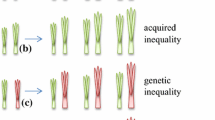Summary
Three intensities of mass honeycomb selection (14.3,5.3 and 1.6%) applied to an unselected rye population gave respectively an annual yield response of 0.28, -3.69 and -5.20% at 15 cm spacing, and of 4.07, 5.39 and 8.99% at 90 cm spacing. The negative response with competition was explained by strong negative correlation between competing and yielding ability which causes positive skewness because of transposition of low yielders and strong competitors from the left to the right tail of the distribution. The positive response in the absence of competition was mainly due to the increased genotypic differentiation which allowed effective discrimination between high and low yielding genotypes. The efficiency of the selection in the absence of competition was further improved by using the honeycomb designs which adjust soil heterogeneity and application of very high family and individual selection pressures.
Two cycles of mass honeycomb selection increased the population yield by 29.4%, one cycle of mass plus one cycle of pedigree honeycomb selection did so by 34.5%. The results are discussed in relation to the selection response and to the efficiency of various breeding schemes.
Similar content being viewed by others
References
Blijenburg, J. G. & J. Sneep, 1975. Natural selection in a mixture of eight barley verieties, grown in six successive years. 1. Competition between the varietics. Euphytica 24: 305–315.
Bos, I., 1981. The relative efficiency of honeycomb selection and other procedures for mass selection in winterrye (Secale cereale L.). Doctoral thesis, Agricultural Univ., Dept. of Plant Breeding, Wageningen, pp. 172.
Christian, C. S. & S. G. Gray, 1941. Interplant competition in mixed wheat populations and its relation to single plant selection. J. Coun. Scient. ind. Res. Aust. 14: 59–68.
Falconer, D. S., 1981. Introduction to quantitative genetics. Longman, London and New York. 340 p.
Fasoulas, A., 1973. A new approach to breeding superior yielding varieties. Dept. Genet. Plant Breed., Aristotelian Univ. Thessaloniki, Greece, Publ. 3. 42 pp.
Fasoulas, A., 1978. Selection for yield in the absence of the masking effects of competition and soil heterogeneity. XIV International Congress of Genctics. Sections 21–32, p. 75. Moscow 1978.
Fasoulas, A., 1981. Principles and methods of plant breeding. Dept. Genet. Plant Breed., Aristotelian Univ., Thessaloniki, Greece, Publ. 11, 147 pp.
Fasoulas, A., 1983. Rating cultivars and trials in applied plant breeding Euphytica 32: 939–943.
Fasoulas, A., 1984. Effects of competition in the selection process. In: W. Lange, A. C. Zeven & N. G. Hogenboom (Eds), Efficiency in plant breeding. Proceedings of the 10th Congress of the European Association for Research on Plant Breeding, EUCARPIA, Wageningen, the Netherlands, 19–24 June 1983. pp. 35–39.
Fasoulas, A. & A. Tsaftaris, 1975. An integrated approach to plant breeding and field experimentation. Dept. Genet. Plant. Breed., Aristotelian Univ., Thessaloniki, Greece, Publ. 5. 37 pp.
Hamblin, J. & J. G. Rowell, 1975. Breeding implications of the relationship between competitive ability and pure culture yield in self-pollinated grain crops. Euphytica 24: 221–228.
Jensen, N. F. & W. T. Federer, 1965. Competing ability in wheat. Crop Sci. 5: 449–452.
Kannenberg, L. W. & R. B. Hunter, 1972. Yielding ability and competitive influence in hybrids mixtures of maize. Crop Sci. 12: 274–277.
Kawano, K. & M. D. Thung, 1982. Intergenotypic competition and competition with associated crops in Cassava. Crop Sci. 22: 59–63.
Kawano, K., C. Tiraporn, S. Tongsri & Y. Kano, 1982. Efficiency of yield selection in Cassava populations under different plant spacings. Crop Sci. 22: 560–564.
Khalifa, M. A. & C. O. Qualset, 1974. Intergenotypic competition between tall and dwarf wheats. I. In mechanical mixtures. Crop Sci. 14: 795–799.
Montgomery, E. G., 1912. Competition in cereals. Nebraska Agric. Expt. Stn. Bull. 127, 22 pp.
Smith, O. D., R. A. Klefse & D. D. Stuthman, 1970. Competition among oat varieties grown in hill plots. Crop Sci. 10: 381–384.
Spitters, C. J. T., 1979. Competition and its consequences for selection in barley breeding. Agric. Res. Rep. 893. Wageningen, pp. 268.
Wiebe, G. A., F. C. Petr & H. Stevens, 1963. Interplant competition between barley genotypes. In: W. D. Hanson & H. F. Robinson (Eds), Statistical genetics and plant breeding. Publ. 982, Ntnl. Acad. Sci., Ntnl. Res. Counc., Washington D. C., pp. 546–557.
Yamane, T., 1973. Statistics, an introductory analysis (3d ed.). Harper & Row. Publishers, Inc., N. Y. 1130 p.
Author information
Authors and Affiliations
Additional information
Part of senior author's doctoral thesis
Rights and permissions
About this article
Cite this article
Kyriakou, D.T., Fasoulas, A.C. Effects of competition and selection pressure on yield response in winter rye (Secale cereale L.). Euphytica 34, 883–895 (1985). https://doi.org/10.1007/BF00035428
Received:
Issue Date:
DOI: https://doi.org/10.1007/BF00035428




